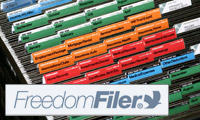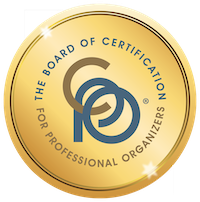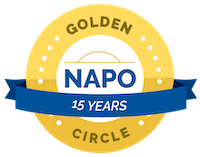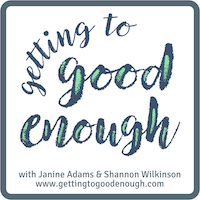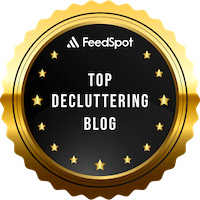Using self care to prepare for decluttering

In May, I republished one of my favorite blog posts, Self-care, which is about the importance of taking time for self care even if you feel like you should be working on decluttering and organizing your home. I suggested that you could use self-care activities as a reward for making some progress on your organizing projects.
I received a lovely email response from reader Joan Paul who suggested that self care could be an important way to prepare for the stress of a decluttering and/or organizing session.
She wrote:
Maybe filling our tank with self-care before starting a decluttering project is just as key or even more important than using it as a reward. Maybe if we are properly nurtured by our self-care we won’t be so paralyzed and overwhelmed about decluttering!
I love that way of thinking and to be honest I hadn’t thought of that way before.
Taking care of yourself is one of the most important things you can do to live a happy and healthy life. If clutter has gotten out of hand and you have difficulty addressing it, then incorporating some self care into the process (whether that’s before or after the decluttering session, or both!) can only benefit you.
Sometimes self care looks like calling in an organizer or an organizing team to jump start your activities or get it done swiftly. (I’m a huge believer in asking for help and wouldn’t have been able to survive last year’s move if I hadn’t hired organizers to get me packed and unpacked.) If you live in St. Louis, we’re happy to help you. If you live elsewhere, you can find an organizer near you at NAPO.net.
Photo by Maddi Bazzocco on Unsplash
Worth repeating: Daily exercise for the win!
I wrote this post three years ago. Since then I’ve started working with a trainer each week, which is great. But I still find it hard to get excited to exercise between training sessions. Reading my brother’s simple approach (especially the concept of any exercise being better than no exercise) is inspiring me to get busy and exercise this morning!
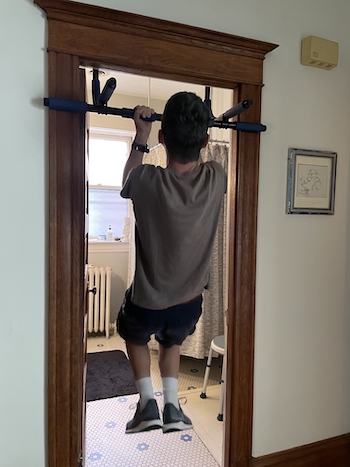
My brother, Larry, is visiting me right now. He lives in Australia, so I don’t get to see him often. Our father died last month in Walla Walla, Washington, and Larry made an emergency trip to the U.S. After the memorial service, he came back to St. Louis with my husband and me.
We’re having a great time hanging out and catching up. And we’re even learning a thing or two from one another. One thing that Larry’s really impressed me with his daily habit of doing pull ups. Larry is a slender, strong 63-year-old man. He’s genetically inclined to being slender but he also has muscles. And now I know why.
Every day, Larry does ten pull ups.
He tells me that he started his pull-up routine in 1995. He started with only four, which was very easy for him to do. He slowly increased the number and now he’s up to ten. Along the way, he’s created a few rules for himself. If he can’t do all ten because he doesn’t feel strong enough, he lets himself take a break. He can make up the difference a little later or, barring that, he’ll make up the difference the next day.
When I asked Larry about his daily exercise habit and how he’s managed to keep it up for literally decades, he said,“It’s easy. That’s the beauty of it. I knew that I had to be flexible about it because I’d lose heart if I tried to force myself to do something that was too difficult. I knew that if I could do it every day it would be good for me. And it’s not something that’s impossible to do.”
There are so many things I love about this:
- His goal is realistic
- He builds some flexibility into it
- He allows himself to fall short but makes up for it
- He’s reaping visible benefits from this daily habit
I feel the same way about my daily yoga practice, which has fallen by the wayside due to a variety of circumstances. But Larry’s inspiring me to get right back on it and allow myself to just do a little bit of yoga and count it as a success. I know daily yoga is beneficial. (I didn’t miss a day for over a year during the pandemic.) My promise to myself is that I’ll let it be easy.
Larry is reminding me that when it comes to exercise (and really almost everything) any effort is better than no effort. His daily ten pull ups takes him literally a couple of minutes. (It’s fortunate that we happen to have a pull up bar just like the one he has at home.) And he’s definitely reaping the benefits!
ETA: I let Larry know I had re-published this blog post and he told me that he’s upped his game. He wrote, “Have I told you I’ve expanded my routine? So now I do 10 pull ups with arms wide, followed by 10 curls with hands close together on the bar. Basically, your standard pull up. Then I do a 60 second plank, 60 second leg lift, 60 second plank. And as before, I’ve got all day to do them. But the pull ups must be done immediately after the arms stretched wide pull ups.” I’m truly impressed by his dedication and how he’s built on his previous successes. And the guy is turning 66 next month!
Waking up to a clean desk
A few days ago, I walked into my office to get started working and the desk was covered with stuff. It was de-motivating to put it lightly.
Here’s how it looked.
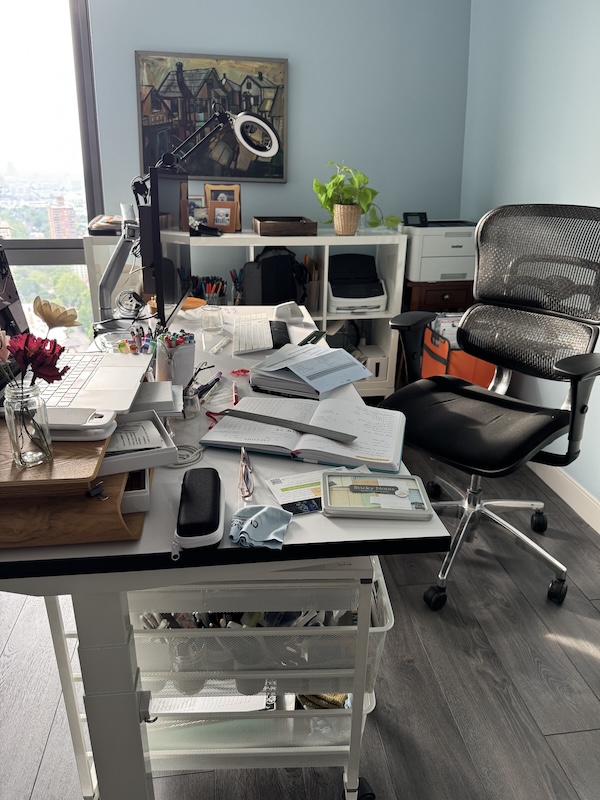
Some days I’ll just push the stuff aside and get busy dealing with my YNAB spending plan or with email. But that day. I decided to see how long it would take me to clear the desktop off. I set the stopwatch on my phone and started tidying.
In only 2 minutes and 45 seconds my desktop looked like this:

Less than three minutes to a clear desktop that made me eager to get to work. It was fantastic.
You know what would have been even better? If I had cleared my desk off the night before so I walk into an office with a clean desk. That clean desk really helps me feel motivated to get some stuff done.
At the day’s end, I almost walked away with the day’s stuff all over my desk. But knowing that it would probably take less than three minutes to clear it off, I decided to do it right then. (It took less than two minutes.)
Over the years I’ve blogged about this many times. Taking a few minutes at the end of the work day to clear off your desk reaps huge benefits to your productivity. When there is just one day’s worth of stuff to put away (assuming you have a place to put it away) clearing your desk takes very little time. And that is time well spent!
The joy of packing light
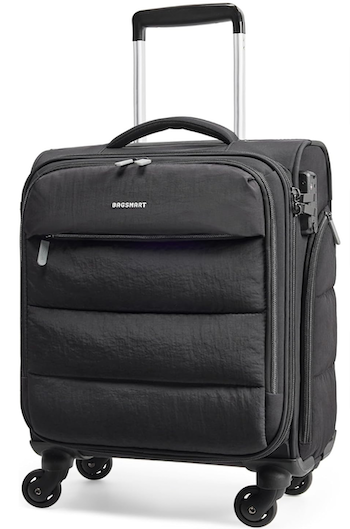
I travel probably six to ten times a year and it’s been more than a decade since I’ve used a suitcase larger than a carry-on. But I always check that carry-on because I haven’t felt tall or strong enough to lift my suitcase into the overhead bin.
Southwest was my airline of choice: it didn’t charge to check a bag and I loved its open-seating policy. But, as you may know, that ended yesterday. I’m not keen on paying to check a bag, so I’m going to be carrying mine on.
I had set a goal with my trainer of being able to easily hoist my bag into the overhead bin, but I decided to take a shortcut to sidestep the issue. I bought an even smaller suitcase, the Bagsmart Under-Seat Carry-On. I paid only about $65 for it and I’ve been very pleased with it.
I’ve taken three trips since buying the bag in March. One involved airplane and train. One was a round-trip Southwest flight and I recently flew to Charlottesville on a pair of Delta flights that were on smaller planes.
This little suitcase was a champ! On the three Southwest flights I took, I was able to place both the suitcase and my purse under the seat in front of me. (I had to sit in a window seat, though; the space under the aisle seat is smaller.) On the Delta flights the bag wouldn’t fit under the seat, but the overhead compartments were so small that all normal-sized carry-on bags had to be gate checked. And the bins were low enough in this small plane (and my suitcase light enough) that I had no difficulty putting my suitcase in the overhead compartment.
I was able to breeze past people who were waiting for their gate-checked bags in the jet bridge. In addition, it was so nice to not have to take time to check my bag (on either end of a flight). I’m a carry-on convert!
The latter two of my trips were four days and three nights. I had plenty of room in my 18” × 13.5” × 8” suitcase for what I packed, which was two dresses, a pair of shoes and a pair of slippers, pajamas and, of course, toiletries. I also took a charging station for my devices and a few extra cords. I packed my laptop, Bullet Journal and pens, in the outer pockets of this little workhorse of a suitcase. (I brought an iPad rather than my laptop on my most recent trip which made my suitcase even lighter.)
The key to my ability to pack light was wearing a lot of layers on travel days, including a warm cardigan that I could pair with any of the items in my suitcase. I’m always cold on a plane, so many layers works well for me. I wear merino wool exclusively and don’t require much variety. (I once wore the same dress for 100 days in a row.)
I find that making the decisions about what to each day before I go on a trip is easier than having a large selection from which to choose while I’m on a trip. I know not everyone is wired like me, but the benefits to traveling light make it worth a try!
Worth repeating (once again): Self-care
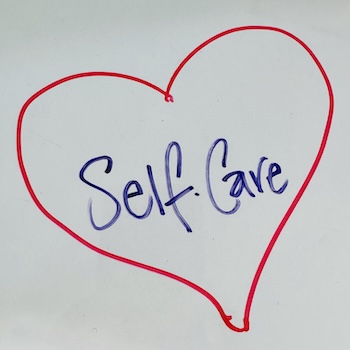
I’m passionate about asking people to be kind to themselves and not let guilt and worry about clutter (or anything else) get in the way of living their lives. Seventeen years ago, I wrote this post, called Self-Care. Thousands of posts later, it remains one of my very favorite posts. I thought I’d share it again today.
I’m always struck how clutter gets in the way of life. I have many clients who constantly feel an obligation to deal with their clutter. They plan to devote a weekend to decluttering, then they start to feel overwhelmed, so they don’t actually deal with it. (Until they call me.)
So for weeks, months, even years, they decline invitations to do fun stuff on their off hours because they should stay home and “get organized.” They don’t treat themselves to a movie, a vacation, or a bike ride because they feel an obligation to stay home and tackle what’s become for them a giant burden.
It breaks my heart.
I’m a big believer in self-care. Maybe because I don’t have kids and therefore have more free time than many women, I have no qualms about taking time away from the “shoulds” and enjoying myself. It happens that I’m easy to amuse—I’m thrilled to sit in front of a DVD of a favorite TV series and knit. That’s my idea of a great time. And I consider that self-care.
Last Sunday I spent the afternoon with some great women, chatting, laughing and doing crafts. Does my bathroom closet need sorting and purging? Oh yeah. It’ll get done some day. But I don’t let it get in the way of the very important hours in the day where I relax and enjoy myself. Getting together with my “craft sisters” nurtures me. And that’s really important.
If you’re reading organizing blogs because you’re feeling disorganized or frustrated by clutter, please don’t let it take over your life. If necessary, seek help (you can find a great organizer via NAPO’s website), and set aside time to work on your organizing project. The key is to actually do the work, rather than intending to do the work and being paralyzed in the process.
And then, please, find time to take care of yourself, rejuvenate your spirits and do something fun. Your idea of fun might be climb a mountain, like my amazing friend Shannon Wilkinson or it might be to take a bubble bath. Maybe you can make a list of things you’d love to do if you only finished getting organized. Then use the items on your list for rewards for the progress you make.
Don’t let clutter get in the way of life. Chip away at it, 15 minutes at a time. Then focus on some self-care. You’re worth it!
Living spendfully
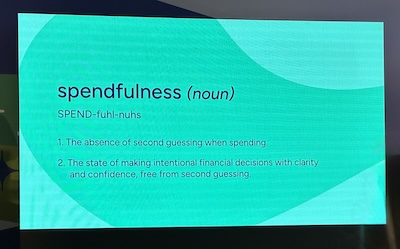
In 2023, I became a YNAB Certified Coach. I help my clients create and maintain spending plans with the YNAB app. Originally, YNAB stood for You Need A Budget, but they’ve stopped using the B word (Budget) so it’s just YNAB now.
YNAB has coined the term spendfulness, which they define as “the state of making intentional financial decisions with clarity and confidence, free from second guessing.” When you’re living spendfully, your spending is aligned with your values and priorities.
And when you’re living spendfully, life is good.
What does that look like for me? Thanks to YNAB:
- I know exactly how I’m spending my money
- I have no credit card debt
- I give every dollar a job so I am constantly in touch with my financial priorities
- I don’t second guess my spending, which means I don’t feel guilt around my spending
We made the big decision to sell our house and rent a luxury apartment last year, which is completely in alignment with our priorities. That’s going against the grain for most people, but for us it’s absolutely right. YNAB helped us realize that this dream could be a reality.
For me, living spendfully is a way of life. I’ve been using YNAB for my business since 2018 and for our personal finances since 2021. I look at both my personal and business spending plans every single day and I’m disappointed if there aren’t transactions to categorize or dollars to assign. It’s a weirdly fun and rewarding activity for me.
If you’re not familiar with YNAB, I urge you to check it out. (That’s an affiliate link. If you click on it and start a free trial and then subscribe, we both get a free month added to our subscriptions.) It can take a little while to understand how to use YNAB because it’s unlike other budgeting apps and it requires a bit of a mindset shift.
The good news is that YNAB has all sorts of help available: written guides, long and short videos, free workshops and podcasts. There’s also lots of peer help available on social media, like the YNAB Fans Facebook Group and the YNAB subreddit. And there are really helpful YouTube channels. Nick True’s Mapped Out Money YouTube channel is very popular.
If you have the means, you can hire a YNAB Certified Coach. You can learn about my YNAB coaching services at Peace of Mind Spending. Or you can search the YNAB Certified Coach Directory to find one who resonates with you.
My wish for you is that you can become spendful. It can create such peace of mind!
Reminding myself of the value of yoga
If you’ve been reading this blog for a few years you know I had an amazing streak of daily yoga. Especially during the pandemic, I was able to do yoga every single day and did it daily for over a year.
But my yoga practice has become spotty. Since we moved to an apartment last summer, my challenge has been space. I can’t leave a yoga mat out so I have to roll it out onto my office floor every day and roll it back up again. In fact, I have to unroll and roll up two yoga mats, because my original one isn’t thick enough for our non-carpeted floors. That’s proven to be an impediment and I’ve discovered the key there is to roll out my mat before going to bed. If I do that, I have to step over my yoga mat to get to my desk, which prompts me to just do yoga. I’ve learned through experience that the best time of day for me to do yoga is first thing in the morning. And by first thing, I mean right after I brush my teeth and before I go into the kitchen.
I’m sad that I’m not doing yoga every day, because I know my stiff body would benefit from it. I am working with a trainer these days so I am getting exercise, thank goodness. But the mellow, bendy goodness of yoga is missing.
So today, to remind myself (and perhaps you) of the value of daily yoga, I am re-running this post from August 2020 when I had hit the five-month mark. I hope it inspires all of us!

Today is special for me because it marks five months of doing at-home yoga every day with Yoga with Adriene. That’s 153 days in a row of yoga. It’s gone from something I felt like I should do (even when I didn’t really feel like it) to something I want to do. There’s no longer a question of whether I’ll do it. The question is just which yoga video I’ll do. I almost always do it in the morning, before walking Bix. It’s a lovely way to start the day.
In June, after two months of daily yoga, I wrote a post about why I love Yoga with Adriene. I just re-read it and I don’t think I can improve upon the reasons I enumerated, so here they are again:
Nine things I love about Yoga with Adriene
- I’m getting stronger and more flexible. I’m 57 years old. I am absolutely thrilled to be getting stronger and more flexible, not the other way around.
- It’s good for my body and my mind. Stilling my mind, breathing deeply and moving my body are absolutely what I need right now.
- It’s gentle. Adriene is such a kind and gentle communicator. Her workouts are full of love and body acceptance. She suggests modifications for every pose and normalizes the idea that you might be not able to do all the stretchy bendy things she can do.
- Adriene is funny. She’s a yoga goddess with a beautiful body but Adriene is self-deprecating and makes funny comments all the time. (Today she bowed her head, then commented, “I see toothpaste on my shirt. Class act.”)
- There are many options, but I don’t have to make a choice. I’m easily overwhelmed by options. Adriene offers 30-day yoga journeys every January where you just do the workout designated for that day. (You can start any time.) No choice necessary. She also offers a themed calendar every month, so you can do the workout for that day. (This month the theme is, appropriately enough, Courage.) So far, I’ve done three different 30-day journeys, two of them twice. I’ve done 2020’s Home twice, 2015’s 30 Days of Yoga twice and 2019’s Dedicate once. I love that I don’t necessarily have to choose which of her many videos to do!
- The workouts are varied but there’s continuity. Each workout has some sort of theme—it might be for a certain part of the body (today I did neck and shoulder relief) or it might be to create a certain feeling, like “Soften”. After doing it this long, the yoga poses are familiar but there endless ways to put them together and each workout feels fresh to me.
- It’s free! Adriene does have a paid community, but all the workouts on her YouTube channel are free. And they’re not interrupted by ads.
- I get to do yoga in my pajamas. I know if would be very hard for me to leave the house to do yoga. Now, I just have to take a few steps from my office to my guest room to do yoga in the morning. And most mornings I do it in my pajamas. Talk about letting it be easy!
- Benji. Adriene’s Australian Cattle Dog, Benji, is present in almost all the videos. He’s calm and zen and adorable. Usually he’s extremely well behaved but occasionally he does something funny (like the time he sat on Adriene’s head when she was in child’s pose.) Adriene always acknowledges him and treats him with love.
I had been thinking about doing yoga for literally years. And now it’s part of my life. I think the reason I could get started and stick with it was that I got rid all the barriers—it literally couldn’t be easier for me to do from my home, often in my pjs. (Plus, I was inspired by my awesome niece, Miranda, who won’t start her day without it.)
I’m going to be taking a two-week driving trip soon and I intend to keep up the daily practice. I won’t be doing it out of a sense of obligation to break the chain. I’ll do it because I want to do it to help my body (and my mind) after long days of driving. I am so grateful to have been able to make this part of my life. [ETA: I did do daily yoga on that trip. And it was helpful!]
Is there something you’ve been wanting to incorporate in your life that you’ve had trouble starting? Maybe take a look at the barriers and see if you can set them aside. I’m really glad I did.
Links
- Peace of Mind Spending
- Getting to Good Enough podcast
- Organize Your Family History
- Institute for Challenging Disorganization
- National Association of Productivity and Organizing Professionals
- Are you interested in becoming a professional organizer?
- NAPO St. Louis
- Shannon Wilkinson, life coach
- Ravelry




